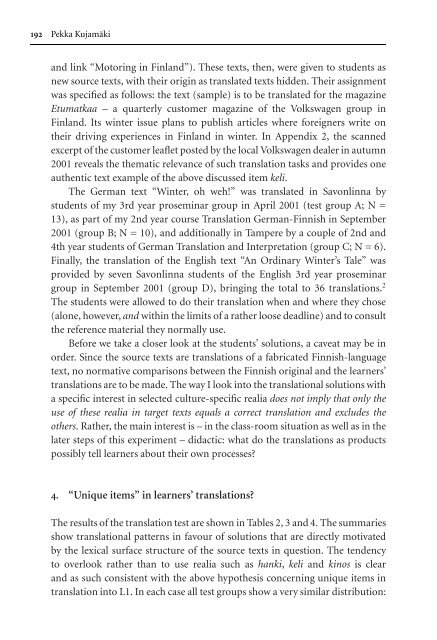Translation Universals.pdf - ymerleksi - home
Translation Universals.pdf - ymerleksi - home
Translation Universals.pdf - ymerleksi - home
You also want an ePaper? Increase the reach of your titles
YUMPU automatically turns print PDFs into web optimized ePapers that Google loves.
192 Pekka Kujamäki<br />
and link “Motoring in Finland”). These texts, then, were given to students as<br />
new source texts, with their origin as translated texts hidden. Their assignment<br />
was specified as follows: the text (sample) is to be translated for the magazine<br />
Etumatkaa – a quarterly customer magazine of the Volkswagen group in<br />
Finland. Its winter issue plans to publish articles where foreigners write on<br />
their driving experiences in Finland in winter. In Appendix 2, the scanned<br />
excerpt of the customer leaflet posted by the local Volkswagen dealer in autumn<br />
2001 reveals the thematic relevance of such translation tasks and provides one<br />
authentic text example of the above discussed item keli.<br />
The German text “Winter, oh weh!” was translated in Savonlinna by<br />
students of my 3rd year proseminar group in April 2001 (test group A; N =<br />
13), as part of my 2nd year course <strong>Translation</strong> German-Finnish in September<br />
2001 (group B; N = 10), and additionally in Tampere by a couple of 2nd and<br />
4th year students of German <strong>Translation</strong> and Interpretation (group C; N = 6).<br />
Finally, the translation of the English text “An Ordinary Winter’s Tale” was<br />
provided by seven Savonlinna students of the English 3rd year proseminar<br />
group in September 2001 (group D), bringing the total to 36 translations. 2<br />
The students were allowed to do their translation when and where they chose<br />
(alone, however, and within the limits of a rather loose deadline) and to consult<br />
the reference material they normally use.<br />
Before we take a closer look at the students’ solutions, a caveat may be in<br />
order. Since the source texts are translations of a fabricated Finnish-language<br />
text, no normative comparisons between the Finnish original and the learners’<br />
translations are to be made. The way I look into the translational solutions with<br />
a specific interest in selected culture-specific realia does not imply that only the<br />
use of these realia in target texts equals a correct translation and excludes the<br />
others. Rather, the main interest is – in the class-room situation as well as in the<br />
later steps of this experiment – didactic: what do the translations as products<br />
possibly tell learners about their own processes?<br />
4. “Unique items” in learners’ translations?<br />
The results of the translation test are shown in Tables 2, 3 and 4. The summaries<br />
show translational patterns in favour of solutions that are directly motivated<br />
by the lexical surface structure of the source texts in question. The tendency<br />
to overlook rather than to use realia such as hanki, keli and kinos is clear<br />
and as such consistent with the above hypothesis concerning unique items in<br />
translation into L1. In each case all test groups show a very similar distribution:
















